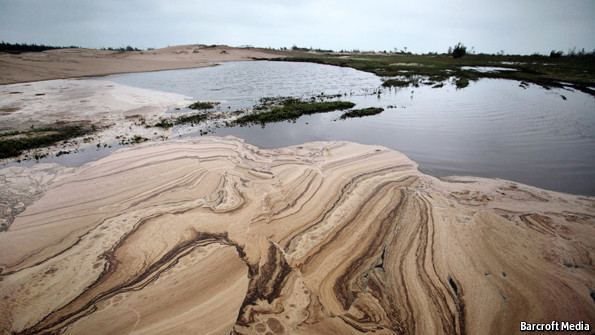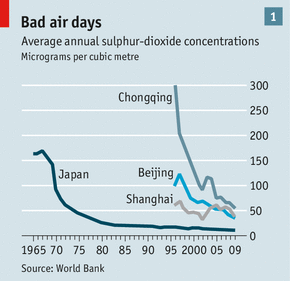Since 1979, China has undergone rapid economic
growth, especially due to market reforms that concentrate on exports. This
development led to environmental degradation, which were ignored until recent
years (Zhang, 2012). Today, various environmental issues account for 9% of the
country’s GDP, namely to health damage from air pollution and soil nutrient
degradation (The Economist). The Environmental Performance Index, created by Yale
and Columbia Universities, ranks China at 116 out of 132 countries (Zhang, 2012): 43% of its surface water and 57% of its urban groundwater are too
polluted for use, and soil pollution is dramatic to such an extent that its
data is ‘state secret’. Northern China is under severe water stress, which is worsened
by pollution, and 80 million people are living at sea level and are threatened
by sea-level rise (Grumbine, 2013).
Figure 1. A river in China
Source: The Economist
The World Health Organization (WHO) estimated
that 656,000 died prematurely from sickness related to air pollution in China. Let’s
take Beijing as an example: Last year, the government released false statistics
that air quality was improving within the city – experiencing 286 ‘blue sky’
days in 2011. In reality, anyone who lives there can insure that heavy smog
persisted throughout the year. This event triggered the citizens to demand the
government to track particulates of 2.5 microns or less (PM 2.5), which
originate from dust and emissions from vehicles, coal combustion, factories and
construction sites. They are the main culprit for smog formation and easily
enter the lungs and bloodstream. From January 2012, Beijing began to release
hourly monitoring statistics of PM 2.5, which is four to six times above
American limits (LaFraniere, 2012). Another tipping point for the people came in
January 2013, when warm air settled over the region, trapping pollution from
200 coal-fired power plants and five million cars.
As a result of this, the Chinese government
tightened its reforms on air pollution, forming its first carbon market and
delegating more responsibility to local officials to monitor environmental
development (The Economist). Although the Communist Party will not slow down its
economic reform, its new policies will incorporate more social and
environmental elements (Grumbine, 2013). It plans to spend $275 billion over the next
five years to clean up its air. Apart from the odd spike in Beijing in the
beginning of this year, air quality has generally been improving (The Economist):
Figure 2. China's bad air days have been decreasing
Source: The Economist
China has begun to relocate factories, reduce
coal burning, raise vehicle emission standards (LaFraniere, 2012), and reduce the number of
new cars registered within its big cities (Yale). Most of its improvement is
due to a scheme that forced 1,000 state-owned enterprises (SOEs) to use energy
more efficiently – complying with building codes, efficiency targets, etc. At
present, 10,000 SOEs are involved (The Economist).
Wang Yuesi, chief air pollution scientist at the
Chinese Academy of Scientists, say that China needs twenty more years to meet
WHO standards (LaFraniere, 2012). They used to say, ‘grow first, clean up later’. China looks
like an expert, turbo-speed cleaner: it is the world’s biggest polluter and green energy investor, concentrating
on mainly wind and solar power, with plans of nuclear power stations. The West
believes that China has an advantage of imposing tougher policies that
democrats tend to avoid. However, when it comes to the environment, local
officials can quietly ignore policy – ‘center proposes; provinces and counties
disposes’ (The Economist).
References:


I read in the news recently that global warming trends have slowed recently due to increased sulphate aerosols in the atmosphere from the increasing number of large factories in China and SE Asia. Apparently they are providing a temporary cooling mechanism by seeding more clouds and increasing the earth's albedo. Volcanic eruptions have the same effect but on a smaller scale, and less constantly than anthropogenic sources. Have you read anything about this? Would be interested to hear your opinion. I guess there are problems associated like acid rain and potentially a more dramatic warming after the aerosols are removed from the atmosphere.
ReplyDelete